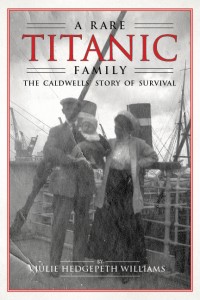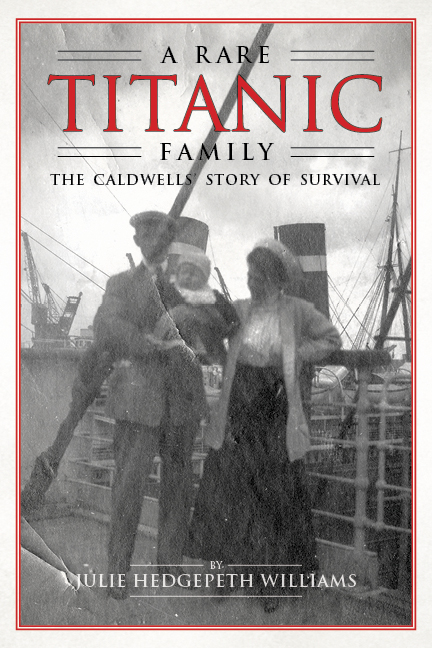Dr. Julie Williams Part of a Rare Titanic Family
Share the post "Dr. Julie Williams Part of a Rare Titanic Family"
 In the last one hundred years of American history, few events have captured the imagination like the sinking of the “unsinkable” Titanic April 14, 1912. The tragedy of the maiden voyage of the biggest ship in the world at that time holds many diverse story lines, from heroism on a grand scale to cowardice that makes one’s stomach turn. The fate of the ship and those aboard it, whether they survived or perished, are forever etched in our consciousness.
In the last one hundred years of American history, few events have captured the imagination like the sinking of the “unsinkable” Titanic April 14, 1912. The tragedy of the maiden voyage of the biggest ship in the world at that time holds many diverse story lines, from heroism on a grand scale to cowardice that makes one’s stomach turn. The fate of the ship and those aboard it, whether they survived or perished, are forever etched in our consciousness.
While movies such as the record-setting Titanic starring Leonardo DiCaprio and Kate Winslet renewed interest in the ill-fated sea liner, many books and documentaries are produced regarding the sinking of the great ship every year. One of the more interesting, however, is A Rare Titanic Family, written by Illinois native Dr. Julie Williams and describes the survival of not only her great uncle, Albert Caldwell, but his wife Sylvia and their son, Alden. They were one of the very few families to survive the incident intact.
At a recent lecture at the Left Bank Books in the Central West End, Williams, in full period clothing, spent nearly two hours not only discussing the amazing story that led to her great uncle Albert ending up on the Titanic, but the process of researching the book, and answering questions from the audience. Williams is a natural performer, singing a song from the Titanic era to kick off the event and inserting anecdotes and jokes within the scripted portion of the program.
For me personally, the most interesting part of the story is the fact that Albert and Sylvia, despite having survived one of the most famous, and most preventable, tragedies in history, ended up divorcing in 1930. Albert, who died in March, 1997 at age 91, later remarried a woman named Jenny, who was Williams’ great aunt and the conduit bringing Albert into the family. When asked, Williams said it was a point of pride for Albert and Sylvia to remain friendly with one another, not just for the sake of their son, but also considering what they had endured so much together.
“He always looked 150 years old and acted 25,” Williams said of Albert. “He never had a problem talking about it with us and we grew up hearing about it. We jokingly used to blame Sylvia for getting them into that mess since she wasn’t our relative.”
Considering Sylvia’s role in the adventure, that may not be an erroneous assumption. The two were based in Siam as missionaries after their marriage in 1909 and were expected to stay there for a contracted period of time. After awhile, Sylvia claimed she was sick and wanted to go home. The heads of the missionary were having none of it, but she eventually won out and she, her husband, and their newborn son were allowed to leave. Years later, it was alleged the homesick wife and mother was only feigning her illness in an effort to leave Siam, but whether or not that is true, no one will ever know for certain.
After weeks of travel, the three made their way to England. Albert, in what may be one of the worst decisions in the history of travel, decided against buying return tickets to America via the Carpathia, instead opting for the more opulent Titanic, based on a poster of the grand ocean liner hung in their hotel.
“It was Sylvia who asked a question that led to one of the most famous quotes made regarding the Titanic,” Williams said. “She asked a bag handler ‘Is it true this ship is unsinkable?’ The man looked at her and with no hesitation said ‘Yes, lady. God Himself couldn’t sink this ship.’”
God, apparently up for the challenge, proved him quite wrong a few days later.
Anytime there is a story of survival against the odds, rarely do those who live to tell the tale simply survive. There are usually choices to be made, a favor exchanged, a moment where fate intervenes. The Caldwells’ survival is a splendid example.
Albert was a photographer and brought his camera with him aboard the ship. As he explored the vessel, he made his way to the engine room. There, he spoke with the stokers who kept the flames of the engine alive with an endless supply of coal, asking one of them if they would take a picture of him stoking the flame. One of the stokers agreed, thinking it a fine idea for a photo. The two chatted awhile longer and parted company. The next time they would see each other, that same stoker would grab Albert and his young family and force them on a lifeboat as the Titanic began slipping beneath the waves.
Anytime the Titanic is spoken of and there is mention of a man surviving, there is the controversy of whether the man forced his way onto a lifeboat or bribed his way aboard or, in some cases, actually dressed like a woman to gain entry. According to Williams, the “Woman and Children First” rule wasn’t enforced as strongly as legend says.
“During the evacuation,” she said, “men weren’t allowed off the port side of the ship. But, they were allowed to enter lifeboats on the starboard side, where Albert was. So I feel confident he didn’t have to bribe his way off the ship.”
In the unearthly silence after the Titanic had finally sunk, the survivors in the lifeboats could hear the lost souls in the water. While few of the lifeboats were actually full, most did not allow those in the water into the boat for fear it would capsize, dooming them all. The sound haunted Albert, and probably most of the survivors, for the remainder of his days.
“Even after 60 years, he said he had to forget the sound of the screams,” Williams said. “Otherwise, you would go crazy thinking about them.”
In an amazing instance of irony, it was the Carpathia, hours later, that arrived and rescued the lost ship’s survivors, bringing them to New York City. Albert would give lectures on the event for the rest of his life, bouncing between jobs as an insurance agent and school administrator. An interview with Albert can be heard on Parade.com.
Sylvia’s story was actually, in my opinion, a little more interesting. She penned a 12-page brochure about the tragedy called Women of the Titanic, which is available in e-book form on various Web sites. Upon her divorce from Albert, she began working at the newly-founded State Farm Insurance company and was in fact the 11th person ever to be hired there. She started as a secretary and later formed a romantic relationship with the founder of the company, whom she eventually married, becoming very wealthy in the process.
In recent years, there have been discussions of bringing the Titanic back to the surface. Items such as dishes, silverware, shoes, and luggage have been salvaged and placed in museums and included in traveling exhibits. A couple years ago, a large section of the ship’s hull was brought above the waves of the North Atlantic. Williams said she is torn on the idea. On the one hand, she doesn’t want to desecrate the site where so many perished, but on the other, she is curious to see the remains. She has little doubt what her great uncle Albert would want.
“He always knew they would find it,” she said, pointing out the fact it wasn’t actually found until years after Albert’s death. “He always thought they would find it and bring it to New York, finishing the journey as it was originally intended.”
A Rare Titanic Family is not only an interesting book on the sinking of the ship, but a great insight to missionary work at the turn of the 20th century as well as a well-researched history of that era. The book can be purchased at Left Bank Books or at Amazon.com. For more information on Dr. Julie Williams, visit her page on Facebook.



